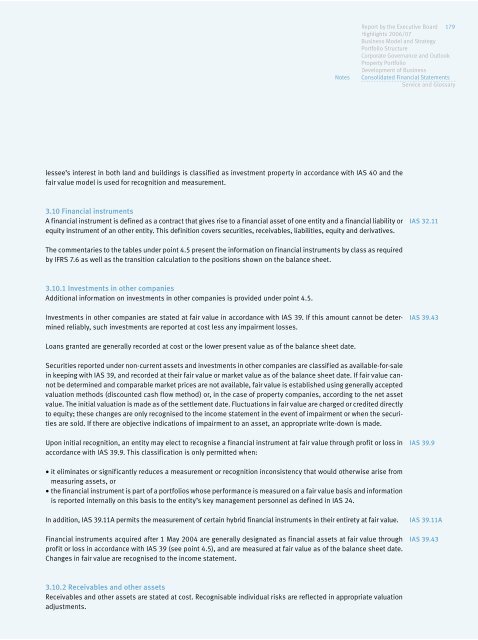IMMOEAST Annual Report 2006/07
IMMOEAST Annual Report 2006/07
IMMOEAST Annual Report 2006/07
Create successful ePaper yourself
Turn your PDF publications into a flip-book with our unique Google optimized e-Paper software.
lessee’s interest in both land and buildings is classified as investment property in accordance with IAS 40 and the<br />
fair value model is used for recognition and measurement.<br />
3.10 Financial instruments<br />
A financial instrument is defined as a contract that gives rise to a financial asset of one entity and a financial liability or<br />
equity instrument of an other entity. This definition covers securities, receivables, liabilities, equity and derivatives.<br />
The commentaries to the tables under point 4.5 present the information on financial instruments by class as required<br />
by IFRS 7.6 as well as the transition calculation to the positions shown on the balance sheet.<br />
3.10.1 Investments in other companies<br />
Additional information on investments in other companies is provided under point 4.5.<br />
Investments in other companies are stated at fair value in accordance with IAS 39. If this amount cannot be determined<br />
reliably, such investments are reported at cost less any impairment losses.<br />
Loans granted are generally recorded at cost or the lower present value as of the balance sheet date.<br />
Securities reported under non-current assets and investments in other companies are classified as available-for-sale<br />
in keeping with IAS 39, and recorded at their fair value or market value as of the balance sheet date. If fair value cannot<br />
be determined and comparable market prices are not available, fair value is established using generally accepted<br />
valuation methods (discounted cash flow method) or, in the case of property companies, according to the net asset<br />
value. The initial valuation is made as of the settlement date. Fluctuations in fair value are charged or credited directly<br />
to equity; these changes are only recognised to the income statement in the event of impairment or when the securities<br />
are sold. If there are objective indications of impairment to an asset, an appropriate write-down is made.<br />
Upon initial recognition, an entity may elect to recognise a financial instrument at fair value through profit or loss in<br />
accordance with IAS 39.9. This classification is only permitted when:<br />
• it eliminates or significantly reduces a measurement or recognition inconsistency that would otherwise arise from<br />
measuring assets, or<br />
• the financial instrument is part of a portfolios whose performance is measured on a fair value basis and information<br />
is reported internally on this basis to the entity’s key management personnel as defined in IAS 24.<br />
In addition, IAS 39.11A permits the measurement of certain hybrid financial instruments in their entirety at fair value.<br />
Financial instruments acquired after 1 May 2004 are generally designated as financial assets at fair value through<br />
profit or loss in accordance with IAS 39 (see point 4.5), and are measured at fair value as of the balance sheet date.<br />
Changes in fair value are recognised to the income statement.<br />
3.10.2 Receivables and other assets<br />
Receivables and other assets are stated at cost. Recognisable individual risks are reflected in appropriate valuation<br />
adjustments.<br />
Notes<br />
<strong>Report</strong> by the Executive Board 179<br />
Highlights <strong>2006</strong>/<strong>07</strong><br />
Business Model and Strategy<br />
Portfolio Structure<br />
Corporate Governance and Outlook<br />
Property Portfolio<br />
Development of Business<br />
Consolidated Financial Statements<br />
Service and Glossary<br />
IAS 32.11<br />
IAS 39.43<br />
IAS 39.9<br />
IAS 39.11A<br />
IAS 39.43


